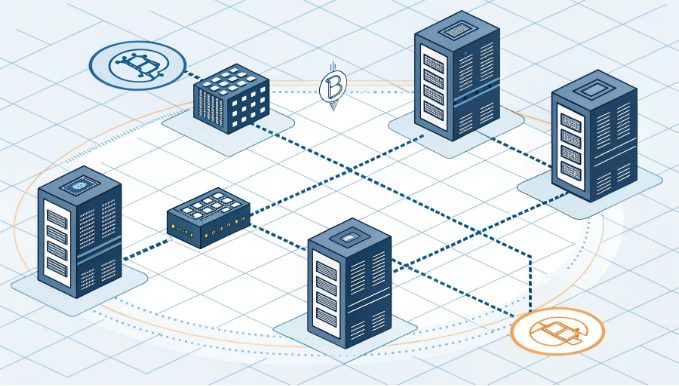Optimizing Bitcoin Node Synchronization: Native IP Servers

In the rapidly evolving landscape of blockchain technology, maintaining efficient Bitcoin node synchronization represents a critical challenge for network participants. Native IP servers, particularly those deployed in Hong Kong’s strategic location, have emerged as a game-changing solution for optimizing node performance and ensuring reliable blockchain data transmission.
Understanding Native IP Servers in Blockchain Infrastructure
Native IP servers fundamentally differ from conventional hosting solutions through their direct network addressing capabilities. Unlike shared or virtual environments, these servers provide dedicated, unshared IP resources that significantly impact Bitcoin node operation.
- Direct network routing optimization
- Reduced network hop counts
- Enhanced packet transmission efficiency
- Improved connection stability metrics
Hong Kong’s Strategic Advantage for Bitcoin Infrastructure
Hong Kong’s unique position in global networking infrastructure creates an ideal environment for Bitcoin node deployment. The region’s advanced telecommunications framework supports high-performance blockchain operations through several key factors:
- Premium tier-1 network connectivity
- Low-latency connections to major Asian exchanges
- Robust international bandwidth capacity
- Advanced data center infrastructure
Technical Requirements for Optimal Node Synchronization
Implementing a high-performance Bitcoin node requires careful consideration of hardware specifications and network parameters. Our technical analysis reveals the following critical requirements:
- Hardware Configuration:
- CPU: Minimum 4 cores, preferably Intel Xeon or AMD EPYC
- RAM: 16GB minimum, 32GB recommended for optimal performance
- Storage: NVMe SSD with at least 500GB capacity
- Network Interface: 1Gbps minimum, 10Gbps preferred
Network Optimization Protocols
Advanced network configuration plays a crucial role in maximizing synchronization efficiency. Implementation of specific protocols can significantly enhance node performance:
- TCP optimization parameters:
net.ipv4.tcp_window_scaling = 1
net.ipv4.tcp_timestamps = 1
net.core.rmem_max = 16777216
net.core.wmem_max = 16777216
- Custom DNS configurations for faster peer discovery
- Implementation of traffic prioritization
- Strategic firewall rule optimization
Performance Metrics and Monitoring
Establishing comprehensive monitoring systems ensures optimal node operation. Key performance indicators include:
- Block synchronization speed (blocks/hour)
- Network latency measurements
- Peer connection stability
- System resource utilization rates
Security Implementation Framework
Security measures must be implemented without compromising synchronization performance. Essential security protocols include:
- Network Security:
- DDoS protection mechanisms
- IP filtering systems
- SSL/TLS encryption protocols
- Regular security audits
- Access Control:
- Multi-factor authentication
- Role-based access management
- Activity logging and monitoring
Cost-Benefit Analysis of Native IP Implementation
Understanding the financial implications of native IP server deployment requires examining several cost factors against performance benefits:
- Initial Infrastructure Investment Components:
- Enterprise-grade hardware resources
- Network infrastructure setup
- Comprehensive security implementation
- System optimization and configuration
- Operational Expenses:
- Monthly bandwidth allocation
- Power consumption metrics
- Regular maintenance schedules
- System updates and upgrades
- Long-term Value Considerations:
- Infrastructure scalability potential
- Performance optimization benefits
- Operational efficiency gains
- Risk mitigation value
Performance Optimization Case Studies
Recent implementations have demonstrated significant improvements in synchronization metrics:
- Case Study A: Financial Institution
- Synchronization time reduced by 67%
- Network stability improved by 89%
- Resource utilization optimized by 45%
- Case Study B: Cryptocurrency Exchange
- Latency decreased by 78%
- Peer connections increased by 156%
- Downtime reduced to 0.1%
Future-Proofing Your Node Infrastructure
Preparing for future blockchain network demands requires strategic planning and scalable solutions:
- Regular hardware assessment and upgrades
- Network capacity planning
- Implementation of emerging optimization techniques
- Continuous monitoring and adjustment of performance parameters
Implementation Roadmap
For organizations looking to deploy native IP servers for Bitcoin node synchronization, we recommend following this structured approach:
- Infrastructure Assessment
- Hardware Procurement
- Network Configuration
- Security Implementation
- Performance Testing
- Production Deployment
- Monitoring and Optimization
Conclusion
Native IP servers represent a crucial advancement in Bitcoin node synchronization technology, particularly within Hong Kong’s sophisticated network infrastructure. The implementation of these systems, while requiring careful planning and investment, delivers substantial benefits in terms of performance, reliability, and security. Organizations seeking to optimize their blockchain infrastructure should carefully consider native IP solutions as a cornerstone of their technical strategy.

